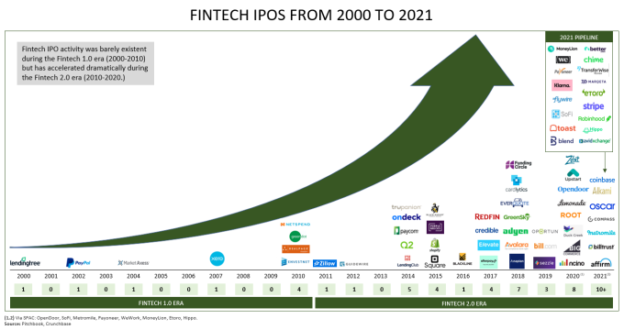FinTechs have long been darlings on Wall Street and in venture capital, garnering votes of confidence in the form of tens of billions of dollars from investors to innovate and disrupt financial services.
At a high level, the traditional narrative has been that the disruption comes at the expense of traditional, incumbent financial institutions (FIs).
But as Terry Angelos, senior vice president and global head of FinTech at Visa, told Karen Webster, there’s a way to bring some of that innovation — $105 billion and counting across more than 2,860 deals, more than the tech and R&D budgets of all the big banks — back into the financial services ecosystem.
The payments giant said Wednesday (May 26) that it would make Visa FinTech Partner Connect more widely available — moving beyond its initial presence in Europe (as of November of last year) to reach new markets including the United States, Latin America, the Caribbean, Europe, the Middle East and Africa.
The initiative helps issuing partners move toward digital-first experiences — tapping into the innovation coming out of FinTechs. Visa has said that the issuers will be linked with “vetted and curated” (with the advantages of discounted pricing or reduced implementation fees) technology partners and providers.
Call it cross-pollination on a global stage, searchable, across an online platform.
According to Angelos: “This is about bringing innovation from tech companies — some of them FinTechs — to our existing clients, many of which are traditional banks, and some of which are also FinTechs.”
For account opening those partners include Provenir, Onfido, Neuro-ID, Middesk, Jumio and others. Cardholder services partners include TravelBank, FirstSource, Fintel Connect and Extend. And, said the firm, partners for data aggregation and analytics include Very Good Security, Provenir, Skyflow, Railz and others.
As Angelos told Webster, we’re in an age where accounts can be opened in minutes on mobile devices, and consumers are expecting that level of ease and service in a digital world.
Making The Introductions
He said that in terms of outreach efforts, Visa’s clients can contact the payment network’s partners through the Visa Partner site, or Visa will, in some cases, make the necessary introductions.
Visa, he said, is in a position to help its larger clients tackle online identity management and security, and for smaller clients who don’t have comparable IT or capital resources, partnering with the vetted partners can bolster self-service capabilities.
Angelos noted that, in linking FinTechs with clients in the expanded program, the vetted and curated firms may have multiple certifications. Visa Ready partners, for example, can help launch payment solutions and help connect clients to Visa infrastructure. Other FinTechs, who are not yet Visa partners, can go through the Fast Track program to gain access to Visa’s network.
Visa’s vetting process, he said, focuses on bringing FinTechs onboard that are sufficiently funded and able to handle the demands of Visa clients, along with security audits and background checks.
“We also want to have multiple partners in each of these capabilities,” said Angelos, who added, “We’re not in the business of picking winners. I’d rather have a set of partners that clients can use.”
Virtual Cards And Beyond
Now more than ever, he said, banks have to pivot toward onboarding their users digitally. He pointed to VGS and Skyflow, among others, as having helped partners cut onboarding times by about half.
FinTechs are talking advantage of those streamlined workflows, said Angelos, and so are traditional clients who are building new services. Other firms want to leapfrog the complexities of creating and mailing physical corporate cards, embracing digital issuance instead.
Beyond the key areas of identity management, security, card issuance and onboarding, Angelos said that the partnerships will focus on “go to” services that can broaden the capabilities that can be used by clients — including data management, and cryptos.
As Angelos told Webster, Visa (as a rails provider) ultimately benefits as issuers, FIs and other clients build better, more digital consumer and business products.
And, he added, the Partner Connect program is illustrative of the sea change in how FIs and FinTechs view one another.
Banks, with scale and reach, and a significant amount of cash on their balance sheets, may have once looked to building out FinTech-like capabilities on their own, or eyeing FinTechs as buyout targets.
But as Angelos told Webster, “The dynamics of the FI/FinTech relationships have changed over time.”
That evolution has been tied to the maturation of many FinTechs and the realization of the FIs that partnerships make sense.
Simply put, FinTechs have been building and deploying capabilities that have been complementary to banks — not solely and strictly competitive.
The banks, in turn, have figured out that they cannot be best in class in everything (nor can they buy every FinTech that comes along).
In addition, said Angelos, FinTechs are realizing that FIs have wound up being valuable clients. As the great digital shift persists, he said, the unbundling of the bank will wind up fostering re-bundling in different ecosystems as those ecosystems evolve, as different services and stakeholders come together.
Bringing the right banks together with the right FinTechs will only hasten those ecosystems — to everyone’s benefit.
“I do think it’s a little overlooked how much of the innovation in FinTech ‘goes back’ to really supporting existing financial services companies,” he told Webster. “This is a journey with no end in sight.”
https://www.pymnts.com/news/digital-banking/2021/visa-105-billion-dollars-fintech-investment-banks/amp/





